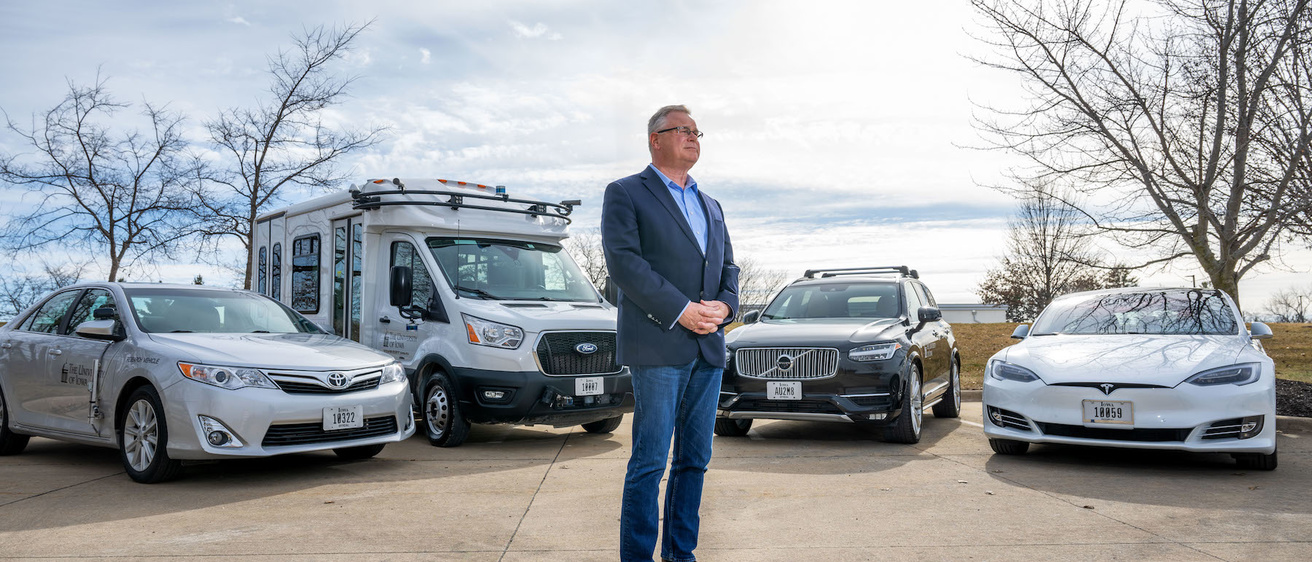ISE’s Daniel McGehee prepares students to make an impact.
Grant Wood’s 1935 painting Death on the Ridge Road hangs on the office wall of Daniel McGehee, director of the University of Iowa’s Driving Safety Research Institute (DSRI).
Two cars are traveling on a rural two-lane road, cresting a hill while a large box truck careens toward them. No shoulders, no escape. Telephone poles stand as abstract crucifixes along the road edge while dark clouds gather on the horizon.
“In rural America, there is little room for error,” said McGehee, professor of industrial and systems engineering. "People often think of crashes as accidents, but each crash has six, seven, eight, or more causes. The goal of our research is to eliminate one or two of these factors and lessen the severity and likelihood of a crash and ultimately injuries and fatalities.”
McGehee has been integral to Iowa’s international reputation in driving safety research for over 30 years, expanding knowledge on driver behavior under impairment, distraction, and the effectiveness of new vehicle technologies.
The Washington state native has led DSRI (home of the National Advanced Driving Simulator) since 2016, which is also when he joined the College of Engineering faculty. Prior to that, he directed the Human Factors and Vehicle Safety Research Division at the University of Iowa Public Policy Center.
Alumni of McGehee’s programs have landed across the globe at Apple, Volvo, Massachusetts Institute of Technology (MIT), Ohio State University, University of Wisconsin–Madison, and the National Highway Traffic Safety Administration (NHTSA).
Zach Noonan worked under McGehee designing a software-hardware interface for naturalistic bicycling research. McGehee also advised Noonan’s PhD in industrial and systems engineering focused on social interactions in automated driving.
“As I have moved on in my career and worked with a lot of other PhDs, I realized that along with the skills Dan taught me directly, he also allowed me the room I needed to be able to develop big, new ideas—a skill that is not easy to teach to a new researcher,” said Noonan, now a researcher at the MIT Center for Transportation and Logistics AgeLab in Cambridge, Massachusetts.
Emily Shull studied under McGehee as a master’s and PhD candidate. Now an engineer at NHTSA, Shull investigates crash avoidance and advanced driver assistance systems. Shull credited McGehee and other industrial and systems engineering faculty for helping her transition from a “non-engineer” psychology major to conducting engineering research.
“Dan has a way of looking at things from a very high level, which is really helpful when you're stuck in the weeds of your own research,” Shull said. “I found this particularly valuable when it came to writing my dissertation. It can be tough to look past the numbers and data and really understand the impact of the work as a whole.”
Morgan Price, a 2013 Iowa biomedical engineering major who added two master’s and a PhD to her resume, has worked with McGehee both as a student and after graduating from Iowa. The methodology she learned at Iowa of conducting studies and applying findings to a product remains fundamental to her work.
“All of the significant opportunities that have shaped the early stages of my career are in some way connected to Dan,” said Price, human factors design engineer at Apple. “He is a fantastic connector with an excellent network. Dan’s legacy is so far reaching.”
ADS for Rural America
The Automated Driving Systems for Rural America project was one of the first in the world to test a highly automated vehicle (AV) on rural and gravel roads. The top nine findings included:
Sensors may not “see” far enough to safely turn onto a high-speed road (55+ mph), and stationary objects may hide oncoming traffic from sensor view.
Particulates in the air such as dust clouds or spray from water sprinklers can sometimes be recognized as obstacles.
Automation doesn't slow down or adapt to weather/environmental conditions or to blind hills and curves.
When the AV comes to a stop, it can creep and be slow to start.
The AV cannot go into an oncoming lane of travel, so it cannot pass farm equipment or other slow-moving vehicles on a two-lane road.
Horse and buggies are categorized as standard vehicles, so the automation doesn't adjust as most humans would when driving by them.
Pedestrian categorization is not always accurate.
For vehicle-to-vehicle (V2V) communication, cellular signal loss can be an issue, especially in remote areas.
Gravel roads are often not wide enough for two standard lanes of travel. Programming the AV to drive closer to the center of a gravel road and then nudging it to the right when needed is difficult behavior to mimic.
